Vehicle to Vehicle ITS

The provision of vehicle-to-vehicle ITS services is very much in its infancy, and tends to centre specifically on two communications technologies: Communications at 5.9 GHz and communications at 63-64 GHz, both of which have been allocated. The provision of vehicle-to-vehicle ITS services is particularly challenging, but some services, particularly in the field of collision avoidance, cannot be practically provided through the infrastructure.
Proponents of vehicle-to-vehicle communications also believe that many of the services envisaged to be provided via the infrastructure, can equally be provided directly vehicle-to-vehicle. Some even feel that mesh networks of vehicles can obviate the need to lay much of the infrastructure otherwise envisaged.
Until larger volume trials in real traffic conditions have taken place, the next stage from technical feasibility trials, the capacity limits of 5.9 GHz technology for vehicle –vehicle communications, and the transmission limitations of 63 GHz technology for vehicle↔vehicle communications cannot be fully established. It is probable that both technologies, and a mix of infrastructure-vehicle, vehicle↔vehicle, and vehicle↔infrastructure-vehicle modes of operation will be used in the end. However, the provision of standards at an early stage, as soon as the most probable technical solutions can be agreed, is essential, and work is already well advanced.
In respect of early generation vehicle↔vehicle services, these will mostly be driver advisory systems. Indeed vehicle control systems using vehicle↔vehicle communications can only be effective when a high proportion of the vehicle population is equipped with compatible ITS communications equipment.
Vehicle >< Vehicle Safety Services

Approaching Emergency Vehicle Warning- Vehicle-to-Vehicle
Emergency vehicles, travelling to sites of incidents, use their ITS communications system, probably in broadcast mode to warn all vehicles on single carriageway roads and when approaching junctions, or vehicles ahead of them on separated carriageways, of their approach as a prioritised vehicle. The warning is carried into the vehicle audio and/or visual display via an ITS communications interface.

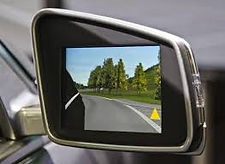
Blind Merge Warning
Provision of warnings (from preceding/adjacent vehicles) to drivers where highways or lanes merge. These in-vehicle electronic systems monitor the position of a vehicle within a roadway lane and warn a driver if it is unsafe to change lanes or merge into a line of traffic. These systems are rearward-looking, radar-based systems. They assist drivers who are intentionally changing lanes by detecting vehicles in the driver's blind spot and passing the information to following vehicles. The warning is carried into the vehicle audio and/or visual display via an ITS communications interface.

Blind Spot Warning
Cooperative driving systems warn vehicles ahead, via an ITS communications interface, of their approach to overtake. The warning is carried into the vehicle audio and/or visual display via an ITS communications interface and in some instantiations is highlighted by a flashing icon in the passenger side wing mirror, so that even if the vehicle is in a blind spot, its approach is made known..

Cooperative Adaptive Cruise Control
Adaptive cruise control is similar to conventional cruise control in that it maintains the vehicle's pre-set speed. Cooperative adaptive cruise control can automatically adjust speed in order to maintain a proper distance between vehicles in the same lane by dialogue, using an ITS communications link, with the preceding vehicle. The ITS cooperative communications link to the vehicle in front, obtains relevant information from that vehicle concerning its speed, acceleration, deceleration, set crujse speed, incidence of manual override, etc.. If the lead vehicle slows down, or if another object is detected, the system sends a signal to the engine or braking system to decelerate. Then, when the road is clear, the system will re-accelerate the vehicle back to the set speed.

Cooperative Collision Warning
Collision warning systems assist the driver read surrounding traffic by warning of the unreasonable approach of an adjacent vehicle. In-vehicle systems achieve this by the use of distance sensing radars and a video screen and audio alert when a vehicle is approaching too rapidly, indicating the direction of the intrusion, and possibly the time to impact and speed of oncoming vehicle. Cooperative collision warning systems collect accurate data from the approaching vehicle and provide warnings, not only to the driver, but to the approaching vehicle using an ITS communications link. The objective is to predict threatening collisions early enough to prevent them from occurring, and by warning the driver to take evasive action. When collision avoidance is not possible, the damages can be limited to a minimum by reducing the speed and stopping distance. The warning is carried into the vehicle audio and/or visual display via an ITS communications interface. Later systems may involve automatically stopping the vehicle.

Cooperative Headlamp Glare Reduction
When an ITS equipped vehicle detects that an approaching vehicle has full headlights on or inappropriately positioned headlights, it advises the offending vehicle of the problem. It is possible to envisage subsequent generation systems automatically triggering headlight dipping using an ITS communications interface.

Cooperative Vehicle-Highway Automation System (Platooning)
(See also Platooning- vehicle assisted below)
This system is a next generation to adaptive cruise control, in which vehicles, communicating with each other form dense platoons at high speed.
With the support of data collected via the infrastructure, accurate inter-car spacing in the platoon is achieved by a longitudinal control system through the use of radar and radio communication between cars and the facilities of adaptive cruise control, i.e. each car in the platoon uses radar to measure the distance to the preceding car. The radio communication system provides each car with broadcast or ITS communications between vehicles providing the velocity and acceleration of the preceding car and the lead car of the platoon. All of these signals are used by the longitudinal feedback control system to continuously determine the desired acceleration of each car. The throttle or the brake is then used to provide the desired acceleration. A knowledge of the dynamic behaviour of the throttle and brake actuators ensures that they are expertly controlled so that the desired acceleration is achieved very accurately.
Since platooning enables vehicles to operate much closer together than is possible under manual driving conditions, each lane can carry at least twice as much traffic as it can today. This will greatly reduce highway congestion. At close spacing aerodynamic drag is also significantly reduced, fuel consumption and exhaust emissions are improved.

Curve Speed Warning - Vehicle Based
Provision of warnings from preceding vehicles to drivers to adapt speed to curve (bend) conditions. May be adaptive to weather and road conditions at the time. Vehicle based curve speed warning systems use signals from preceding vehicles to warn drivers, typically those in commercial trucks and other heavy vehicles, of potentially dangerous speeds in approach to curves on highways. The warning is carried into the vehicle audio and/or visual display via an ITS communications interface.

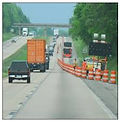
Highway Merge Assistant
Provision of warnings from preceding, adjacent and following vehicles to drivers where highways or lanes merge. These in-vehicle electronic systems monitor the position of a vehicle within a roadway lane and warn a driver if it is unsafe to change lanes or merge into a line of traffic. The warning is carried into the vehicle audio and/or visual display via an ITS communications interface.

Lane Change Assistant
Provision of assistance from preceding, adjacent and following vehicles to assist vehicles to change lanes. The assistance is carried into the vehicle audio and/or visual displays via an ITS communications interface.

Left Turn Assistant - Vehicle Assisted
Provision of assistance to drivers turning left form other vehicles in the vicinity . This countermeasure involves warning motorists making a left turn at a traffic signal of a potential conflict with vehicles approaching from the opposite direction. (Causes a total of 192,000 crashes per year in USA {Barr, 2001}). Data is collected directly using vehicle↔vehicle communications to assist basic sensing to identify potential conflicts by determining the speed and the acceleration or deceleration rate of each vehicle approaching the intersection from the opposite direction, including vehicles executing through and right turn movements. Simple point measurements will not be sufficient, since vehicles can assume various trajectories and acceleration/deceleration/stopping movements, particularly when other vehicles are present. The vehicle↔vehicle communications are effected via an ITS communications interface.
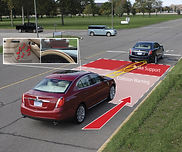
Pre-Crash Sensing – Vehicle↔vehicle Assisted
(See also Pre-Crash Sensing – In-Vehicle)
Pre-crash Sensing functionality is defined in functional steps that require a increasing situation analysis performance and an growing amount of application effort. Each functional step makes it necessary to define the appropriate range of view, the virtual barrier. It is subject to various constraints and the configurations possible Pre-crash Sensing. Pre-crash Sensing technology uses platform radar sensors being designed for the functional integration of possible functions that rely on sensor information from the close surrounding of the vehicle.
The main focus of Pre-crash Sensing is helping passive safety devices in protecting the passenger in all crash situations in. Thus, passive safety devices will no longer be limited to airbags, belt tensioners and active head-rests but using vehicle↔vehicle communications via an ITS air interface will include new restraint systems and automatic brake and steering activation as well. The latter devices – traditionally being active safety devices where there is driver interaction – will more and more be partially automated to compensate for deficits in human reactions.

Post-Crash Warning
Warnings provided to nearby vehicles that the vehicle has been debilitated/damaged by a recent crash event. May include request to pass message to emergency services. The information is transmitted via an ITS communications interface.
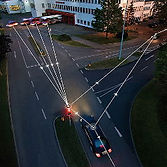
Right Turn Assistant – Vehicle Assisted
Provision of assistance to drivers turning right by receipt of data from adjacent vehicles. See Left Turn Assistant. The assistance data is carried into the vehicle audio and/or visual display via an ITS communications interface.

Road Feature Notification
Information sent via an ITS vehicle↔vehicle communications network to following vehicles of abnormal
road features being approached. May include permanent features such as particularly severe bends where no infrastructure based warning has been received, road deformation and damage, or temporary features such as an obstacle on the road, ice, flood etc. The location of the event is transmitted and the distance from the event and time to reach the event calculated. The message when received sounds a first alert informing the driver of the upcoming event, distance to event and time to event, aurally or via the driver video screen, and provides a second audible/visual warning just before the location of the event is reached.
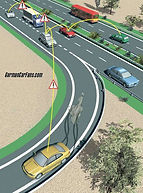
SOS Services – Vehicle Assisted
Provision of connections to vehicles from police and emergency service vehicles for the transmission of voice and/or data communications.; or the forwarding of such communications from other vehicles within the locality. The warning is carried into the vehicle audio and/or visual display via an ITS communications interface.

Stop Sign Movement Assistance- Vehicle Assisted
(See also Stop sign Movement Assistance- Infrastructure Assisted )
This countermeasure involves warning motorists discharging from a stop sign that their movement may conflict with another vehicle. The subject vehicle movement could be left turn, right turn, or through. (causing a total of 362,000 crashes per year in USA {Barr, 2001}.)
Data from adjacent vehicles is used to identify potential conflicts by determining the speed, acceleration, or deceleration rate of each vehicle approaching the intersection and the discharge from the stop line for vehicles at stop-controlled approaches. The data is carried into the vehicle audio and/or visual display via an ITS communications interface.

Platooning- Vehicle Assisted
See also Cooperative Vehicle-Highway Automation System (Platooning)-Infrastructure Assisted)
This system is a next generation to adaptive cruise control, in which vehicles, communicating with each other using an ITS communications air interface form dense platoons at high speed by using vehicle↔vehicle communications using an ITS air interface.
Accurate inter-car spacing in the platoon is achieved by a longitudinal control system through the use of radar and radio communication between cars and the facilities of adaptive cruise control, i.e. each car in the platoon uses radar to measure the distance to the preceding car. The radio communication system provides each car with broadcast or ITS communications between vehicles providing the velocity and acceleration of the preceding car and the lead car of the platoon. All of these signals are used by the longitudinal feedback control system to continuously determine the desired acceleration of each car. The throttle or the brake is then used to provide the desired acceleration. A knowledge of the dynamic behaviour of the throttle and brake actuators ensures that they are expertly controlled so that the desired acceleration is achieved very accurately.
Since platooning enables vehicles to operate much closer together than is possible under manual driving conditions, each lane can carry at least twice as much traffic as it can today. This will greatly reduce highway congestion. At close spacing aerodynamic drag is also significantly reduced, fuel consumption and exhaust emissions are improved.

Road Condition Warning - Vehicle Assisted
Provision of warnings from nearby vehicles to drivers where there are adverse road conditions (for example : Ice, flood, obstacle in road, pothole, spillage, surface deformation etc). The warning is carried into the vehicle audio and/or visual display via an ITS communications interface.
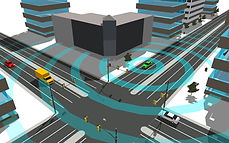
Vehicle Alert
Alerts drivers to the presence of vehicles moving too fast at blind intersections. For example, if the system determines that a car is approaching a driver too fast from the left, an audible alert (e.g. buzzer) will sound and a voice recording will call out: “Car approaching from left” or similar. At the same time, an image of an approaching vehicle will appear on the driver’s navigation screen. The system may also alert a driver when it detects that he or she is approaching a stop sign or red traffic light too fast.

Visibility Enhancer- Vehicle Assisted
(see also In-vehicle Visibility Enhancer)
A system that uses information from nearby vehicles, collected via an ITS air interface, together with in-vehicle infra-red or low light camera techniques to provide enhanced visibility of dark objects, persons and animals in the roadway at night via a head-up display or enhanced display on the drivers video screen. May be supported by audible warnings.

Wrong-way Driver Warning- Vehicle Assisted
(See also Wrong-Way Driver Warning- Infrastructure Assisted)
Warnings from vehicles, transmitted via an ITS communications interface, to offenders, to the road operator, and other road users of vehicles travelling in the wrong direction on a controlled direction carriageway.
When the navigation system of a vehicle identifies that the vehicle is travelling on a controlled direction carriageway or one way road, and vehicle sensors or cameras detect another vehicle driving opposite to the permitted direction, or the driver is proceeding in the wrong direction to that permitted, a warning is sent to the violating vehicle itself (or to the driver via audio/video display), to the traffic control centre and to other nearby traffic.
The warning is carried between vehicles via an ITS communications interface.



